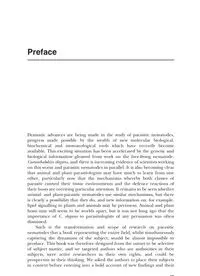
4237-Preface PDF
Preview 4237-Preface
Preface Preface Preface Preface Dramatic advances are being made in the study of parasitic nematodes, progress made possible by the wealth of new molecular biological, biochemical and immunological tools which have recently become available. This exciting situation has been accelerated by the genetic and biological information gleaned from work on the free-living nematode, Caenorhabditis elegans, and there is increasing evidence of scientists working on this worm and parasitic nematodes in parallel. It is also becoming clear that animal and plant parasitologists may have much to learn from one other, particularly now that the mechanisms whereby both classes of parasite control their tissue environments and the defence reactions of their hosts are receiving particular attention. It remains to be seen whether animal- and plant-parasitic nematodes use similar mechanisms, but there is clearly a possibility that they do, and new information on, for example, lipid signalling in plants and animals may be pertinent. Animal and plant hosts may still seem to be worlds apart, but it was not long ago that the importance of C. elegans to parasitologists of any persuasion was often dismissed. Such is the transformation and scope of research on parasitic nematodes that a book representing the entire field, whilst simultaneously capturing the dynamism of the subject, would be almost impossible to produce. This book was therefore designed from the outset to be selective of subject matter, and we targeted authors who are authorities in their subjects, were active researchers in their own rights, and could be prospective in their thinking. We asked the authors to place their subjects in context before entering into a bold account of new findings and their xxi A4015:AMA:Kennedy:First Revise: 19-Mar-01 Preface 21 Z:\Customer\CABI\A4015 - Kennedy - Parasitic Nematodes #L.vp 19 March 2001 11:03:28 Color profile: Disabled Composite Default screen implications, and to emphasize what future developments may now be possible. As a consequence of this strategy, there are many gaps in the coverage in terms of the species dealt with, but we make no apologies for this; it was, in fact, quite deliberate – the principles dealt with will apply broadly, and cross-system research is clearly a way ahead for new principles to be discovered in biological science. In this spirit we have included articles on areas in which C. elegans is playing a major role, and on novel areas of nematode parasitism illuminated by plant-parasitic nematodes. The chapters are also diverse in style and approach, which we encouraged. There are so many scientists of high calibre in nematode parasitology that we found it extremely difficult to choose, but in order to produce a balanced approach we were unable to call on all of the authors whom we would otherwise wished to have included. If this book appears in another edition, however, then we may be able to recruit from amongst the authors who were not included on this occasion. Shortly after completing his chapter, one of the authors, Alan Bird, died suddenly and unexpectedly from a heart attack. It is a fitting tribute to Alan that his last published work is in a book that unites plant- and animal-parasitic nematodes within a framework of basic biology encompassing the C. elegans literature. Alan was one of the first scientists to appreciate the power of the C. elegans model to study parasitic nematodes, and also to realize that the conceptual mechanisms of parasitism by nematodes are catholic, no matter what the host. And this central idea was the driving force behind this book. Malcolm Kennedy William Harnett Glasgow, June 2000 xxii Preface A4015:AMA:Kennedy:First Revise: 19-Mar-01 Preface 22 Z:\Customer\CABI\A4015 - Kennedy - Parasitic Nematodes #L.vp 19 March 2001 11:03:28 Color profile: Disabled Composite Default screen Access to colour illustrations Access to colour illustrations Colour illustrations Access to Colour Illustrations In order to reduce the cost of the book, and thereby improve its accessibility, there are no colour reproductions. Many of the illustrations, however, can only properly be appreciated and understood in colour (particularly those in Chapter 20). The colour illustrations can therefore be viewed and downloaded from the following internet site: http://www.cabi.org/Bookshop/book_detail.asp?isbn = 0851994237 See also http://www/gla.ac.uk/Acad/IBLS/II/mwk/res/images.html If you have any suggestions or problems relating to the illustrations appearing in the book, then please feel free to contact malcolm.
